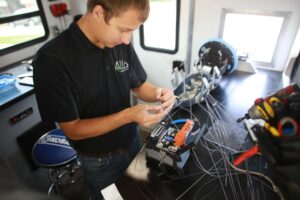Welding optical fibers - work methodology
What is Optical Fiber?
Simply put, an optical fiber is a cable made of glass fiber and plastics. It was designed to seamlessly transmit data. The data transfer process takes place by means of a light wave that reaches enormous speeds - even up to several Tb / s (terabits per second). Its phenomenon is that it works regardless of weather conditions. Comparing the traditional network of copper conductors with the invention of the technological revolution, the fiber optic connection is unrivaled. The stability of data transmission via optical fibers made it the most popular telecommunications service today. It is worth adding that the fiber optic medium is not only used to transfer internet data. It is also used to transmit the highest quality telephone or television signal. However, in order to be able to use this innovative service, installers have several stages of work, incl. welding.
Mounting process
Installing a fiber optic connection is a real challenge. The most work is waiting for installers, whose tasks can be divided into several stages:
- work related to laying cables,
- welding work,
- installation work
In this part, we will deal with the second stage, i.e. welding, which is considered to be one of the most difficult parts of installers' work in assembling optical fibers.
Fiber optics and welding
After laying the cables quite simply, it's time for the stage that requires precision and accuracy. The aim of the welder is to join the joints and join the fibers that make up the optical fibers. There are several methods to achieve this. The most popular ones include: mechanical welding - with the use of mechanical joints and thermal welding with the use of a welding machine, and the third option, i.e. the technique of polishing joints and gluing.
Mechanical welding
It is definitely cheaper than the thermal option, but it invariably comes at a price - we bear the burden of a perfect splice of the fibers. However, if not everything goes as planned, it may turn out that a carelessly performed splicing will prevent proper data flow. What's more, when choosing mechanical welding, we will need tools such as:
- cable shears,
- fiber cutter,
- dust-free wipes and appropriate alcohol,
- or a visual fault locator - recommended for this type of work.
Thermal welding
In thermal welding, the first way to join optical fibers is to use a tool such as a welder. Until recently, you could only use the so-called old type welding machines. This variant of the tool was equipped with an eyepiece and two lenses for the best alignment of optical fibers. Remember, in this case precision is the most important! In this version, it was the user who set the parameters manually. However, the record-breaking fiber optic medium required the use of newer tools. It also happened - a modern, automatic welding machine was created. The fiber setting option is performed automatically and the user can observe the whole process through the camera image. We do not have to worry about such important settings and thus precision, and the working time is extremely shortened.
Unfortunately, the more specialized the equipment, the cost of its purchase increases dramatically. This is also the case here. The highest quality welding machines are estimated at tens of thousands of zlotys - although we will also get a low-cost version of the me advanced on the market.
The technique of polishing joints and pasting
It is a method that owes its attractiveness to the fact that it does not require the use of specialized tools. However, you have to remember that choosing this method, on the one hand, we save money, but on the other hand, we have to spend more time. This method is considered to be the most time-consuming and imprecise.
Important tips
Regardless of the method chosen, the length of the cut fiber is very important. Why? Each mechanical weld and welder has a set of specific features, its own specification that must be followed. Failure to take into account these special features may result in a limited transmission of data or completely prevent its flow. The second important tip is accuracy and precision. The welding points of the optical fibers are very sensitive, hence their protection is so important. It is recommended to place ready-made welds in special cans. Another problem arises here - standard boxes are not equipped with places suitable for mechanical splices. There is a solution for this in the form of special handles, which, placed in cans, adapt them to the type of fiber connection. Experienced welders recommend using them because of the quality and convenience, which, in turn, will affect the final result of our work.




































